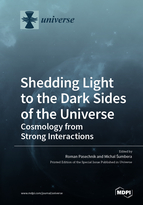Shedding Light to the Dark Sides of the Universe: Cosmology from Strong Interactions
A special issue of Universe (ISSN 2218-1997). This special issue belongs to the section "Cosmology".
Deadline for manuscript submissions: closed (12 September 2020) | Viewed by 20655
Special Issue Editors
Interests: subatomic physics; astronomy; astrophysics and cosmology; grand unification; Higgs physics; supersymmetry; electroweak physics; beyond the standard model; composite models; physical vacuum; quasiclassical gravity; cosmic inflation models; heavy-ion collisions; hard production processes
Special Issues, Collections and Topics in MDPI journals
Interests: relativistic heavy ion physics; multiparticle dynamics; quark–gluon plasma; early universe
Special Issues, Collections and Topics in MDPI journals
Special Issue Information
Dear Colleagues,
The theory of quantum chromo dynamics (QCD), an organic part of the standard model (SM) of particle physics, has been validated by many theoretical and experimental studies. Despite the notable success of QCD in collider measurements over past decades, a proper first-principle understanding of the microscopic mechanism of color confinement in the infrared regime of QCD is still widely perceived as a longstanding theoretical problem. The strongly-coupled QCD dynamics controls colored particles’ (quarks and gluons) collective motion at large spacetime separations and the formation of colorless composite states (hadrons). Whether QCD is a correct theory is a topic for continuous experimental tests, in particular, at new powerful experimental facilities such as the Large Hadron Collider (LHC), currently pushing energy and intensity limits to the furthest ever frontiers. The latter provides the crucial means for progress on a very broad range of topics, performing precision tests of QCD in extreme conditions, at high temperatures and densities.
While QCD theory and the related phenomenology aspects are being intensively studied in laboratory measurements, the possible connections of this important layer of knowledge to cosmology remain rather vague and largely unexplored. No doubt, the physical vacuum has been transformed many times throughout the lifetime of the universe, and has affected its history through a sequence of events, such as the cosmic inflation, phase transitions, and the dark energy dominated expansion. Strong interactions could play an important role in some of these cosmological events. In particular, the emergence of a new state of matter called the quark-gluon plasma at the LHC is often suggested to provide an important source of empirical knowledge to what the universe looked like in the first few moments after the Big Bang. The critical phenomena of the strong interactions and real-time dynamics of confinement have immediate connections to the actively developing research areas of cosmology, such as the physics of the QCD phase transition epoch, the hadronisation of the cosmological plasma, the growth of perturbations, and the evolution of the ground state of the universe throughout its lifespan. Progress in these areas requires a deeper look at the possible interconnections between the theoretical knowledge in quantum YM field theories and (quasi)classical gravity theory on the one hand, and the empirical knowledge from particle physics measurements and cosmological data on another.
This Special Issue aims at creating an overview of the recent progress in these directions by focusing on the novel implications of quantum chromo, or, more generally, Yang–Mills (YM) dynamics, to the physics of the early universe and critical phenomena in cosmology.
Dr. Roman Pasechnik
Prof. Dr. Michal Sumbera
Guest Editors
Manuscript Submission Information
Manuscripts should be submitted online at www.mdpi.com by registering and logging in to this website. Once you are registered, click here to go to the submission form. Manuscripts can be submitted until the deadline. All submissions that pass pre-check are peer-reviewed. Accepted papers will be published continuously in the journal (as soon as accepted) and will be listed together on the special issue website. Research articles, review articles as well as short communications are invited. For planned papers, a title and short abstract (about 100 words) can be sent to the Editorial Office for announcement on this website.
Submitted manuscripts should not have been published previously, nor be under consideration for publication elsewhere (except conference proceedings papers). All manuscripts are thoroughly refereed through a single-blind peer-review process. A guide for authors and other relevant information for submission of manuscripts is available on the Instructions for Authors page. Universe is an international peer-reviewed open access monthly journal published by MDPI.
Please visit the Instructions for Authors page before submitting a manuscript. Submitted papers should be well formatted and use good English. Authors may use MDPI's English editing service prior to publication or during author revisions.
Keywords
- Strong interactions in cosmology
- QCD vacuum
- Dark energy
- QCD phase transition epoch
- Color confinement
- Quark–gluon plasma







